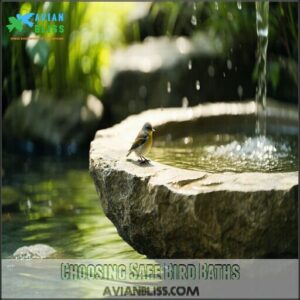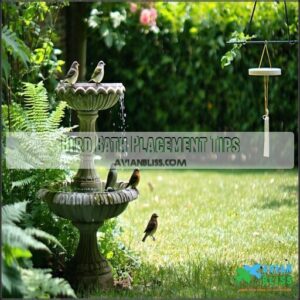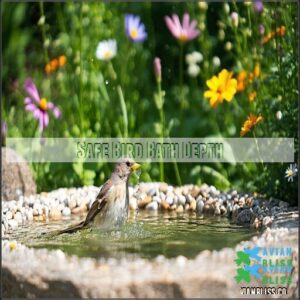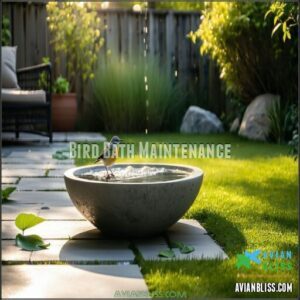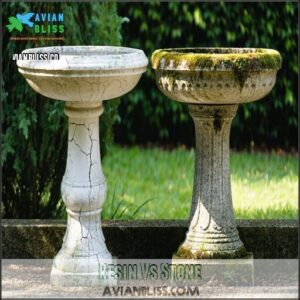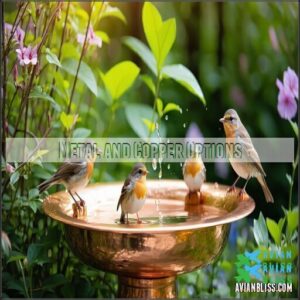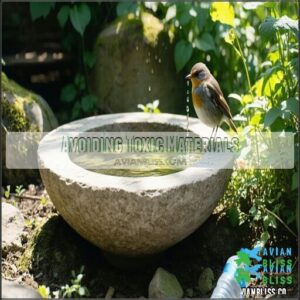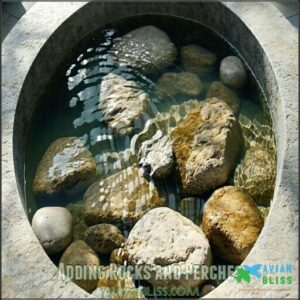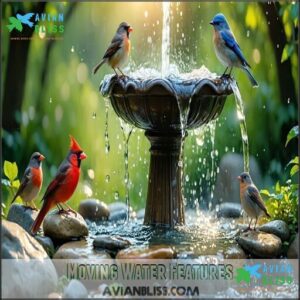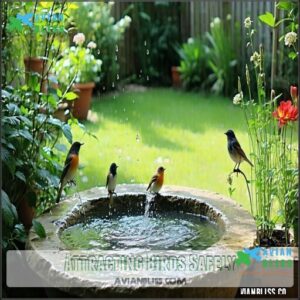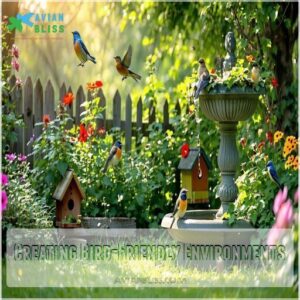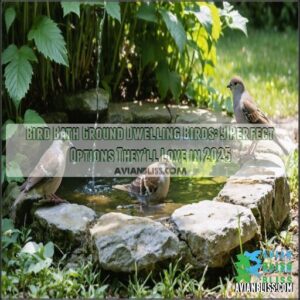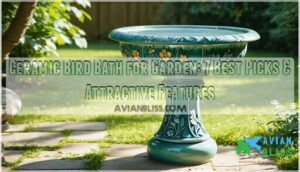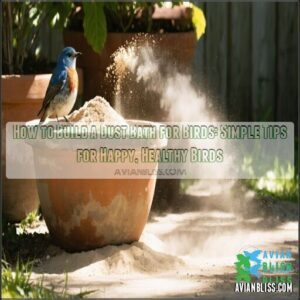This site is supported by our readers. We may earn a commission, at no cost to you, if you purchase through links.
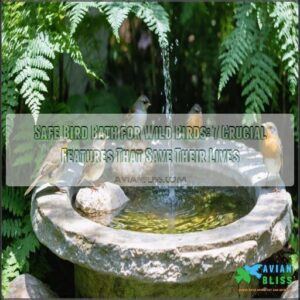
Place your bath in a semi-shaded area, away from predator hiding spots but near shrubs for quick escape routes.
Clean it every 2-3 days to prevent disease—our feathered friends are like dinner guests who don’t wipe their feet, and fresh water is more than a luxury for birds; it’s essential for drinking, preening, and cooling off when they’re feeling like tiny feathered radiators.
Use non-toxic materials like ceramic or stone, and add a few rocks as landing pads to ensure the birds have a safe place to land and preening is made easier, which is essential for their well-being and to keep them feeling like tiny feathered radiators.
Table Of Contents
Key Takeaways
- You’ll protect wild birds by choosing shallow bird baths with textured surfaces and sloping sides, keeping water depth under 2 inches to prevent drowning.
- Place your bird bath in a semi-shaded area away from predator hiding spots but near shrubs for quick escape routes, maintaining a 6-10 foot distance from feeders.
- You’ll need to clean your bird bath every 2-3 days with a mild bleach solution (1:9 ratio) and replace water daily during hot weather to prevent harmful bacteria.
- Use non-toxic materials like stone, ceramic, or copper for your bird bath, and add rocks as landing pads to create a more accessible and safe bathing experience.
Choosing Safe Bird Baths
You’ll need to select your bird bath carefully, focusing on non-toxic materials like stone or copper that won’t harm your feathered visitors when they drink or bathe.
Your choice of a safe bird bath should also feature durable construction with a textured, shallow basin that prevents slipping and allows birds to wade comfortably without risk of drowning.
Your choice of a safe bird bath should also feature durable construction with a textured, shallow basin that prevents slipping and allows birds to wade comfortably without risk of drowning.
Non-Toxic Materials
When choosing a bird bath, non-toxic materials should be your top priority.
Modern bird baths typically use safe resins that won’t harm wild birds even if they accidentally ingest small particles. However, be cautious with older resins which may release microplastic concerns over time.
Material alternatives like stone or copper offer excellent bird safety without toxic substances. For a rustic aesthetic, consider repurposed stone options for your bird bath.
Always verify that any dyes used are certified non-toxic for complete bird bath safety.
Durable Construction
While non-toxic materials keep birds safe, your bird bath’s durability guarantees it remains a reliable water source year after year.
A well-constructed bird bath withstands nature’s challenges without compromising safety.
Consider investing in a long-lasting bird bath for increased resilience.
- Material lifespan varies—stone and copper outlast plastic and resin
- Weather resistance prevents cracking during freeze-thaw cycles
- Structural integrity prevents tipping when larger birds visit
- Solid construction avoids leaks and water loss
- Thick-walled designs resist UV damage and maintain bird bath longevity
The key factors to consider for a reliable bird bath include its ability to withstand various environmental conditions, ensuring it remains a reliable source of water for birds.
Easy Cleaning
You’ll want to look for bird baths that come clean with minimal elbow grease.
Smooth surfaces without crevices prevent algae buildup and make bird bath cleaning a breeze.
| Cleaning Feature | Benefit | Recommended Solution |
|---|---|---|
| Smooth Surface | Prevents algae growth | Non-porous materials |
| Wide Basin | Easy tool access | Brush with extension handle |
| Removable Parts | Thorough cleaning | Detachable basins |
| Simple Design | No hidden crevices | One-piece construction |
| Drain Hole | Complete emptying | Rubber stopper option |
Bird Bath Placement Tips
You’ll save countless bird lives by positioning your bird bath in partially shaded areas away from potential predator hiding spots, ensuring our feathered friends can drink and bathe without becoming someone’s lunch.
For ideal bird health and safety, place your bath about 6-30 feet from feeders to minimize cross-contamination, while keeping the water cool enough to prevent harmful algae growth that could sicken your avian visitors.
Shaded Areas
Now that you’ve selected a safe bird bath, placing it in a shaded area will keep your feathered visitors coming back.
Partial shade offers the perfect balance for wild birds and your maintenance routine.
- Shade keeps water temperature comfortable during hot days
- Reduced sun exposure substantially slows algae growth
- Morning sun with afternoon shade creates the ideal microclimate
- Plant proximity provides quick escape routes for nervous birds
- Dappled light through trees offers bird comfort while maintaining visibility
Predator-Free Zones
Cats lurking in the shadows can turn your bird bath into a hunting ground.
Cats lurking in the shadows can turn your bird bath into a hunting ground.
Position your bath in areas with open sightlines where wild birds can spot danger early.
Create escape routes by placing it 6-10 feet from dense shrubs.
Consider elevated placement (3 feet high) to deter predatory pets.
Plant deterrent plants like thorny roses nearby.
Smart habitat management protects feathered visitors from both ground and aerial predators.
Distance From Feeders
Position your bird bath at least 6-10 feet away from feeders to minimize contamination prevention issues.
This ideal spacing reduces the risk of seed debris falling into water, which can lead to bacterial growth and bird diseases.
You’ll also help prevent territorial disputes as different species can enjoy separate resource availability zones.
Wild birds appreciate this species segregation, allowing nervous drinkers to hydrate in peace while hungrier birds feast at your feeders.
Safe Bird Bath Depth
You’ll protect visiting birds from drowning by keeping water levels in your bird bath between 1-2 inches deep at the center, with edges gradually sloping to just half an inch.
Most wild birds, especially smaller species, won’t venture into deeper water, as they’re testing the waters, not training for the bird Olympics.
Preventing Drowning
Now that you’ve chosen the perfect spot for your bird bath, let’s focus on keeping our feathered friends safe from drowning.
Birds can’t swim like humans do, and a too-deep bath can quickly become a hazard. A shallow bird bath is ideal for preventing accidents.
To ensure the bird bath is safe, consider the following features:
- Add flat stones or pebbles that create safe perching spots above and below the waterline
- Install sloping sides that allow for gradual depth changes from edge to center
- Place textured materials at the bottom to provide grip for tiny bird feet
Ideal Water Depth
Now that you understand how to prevent drowning risks, let’s focus on getting the water depth just right.
The ideal bird bath depth shouldn’t exceed 2 inches at the center, with edges measuring between ½-1 inch.
Birds aren’t looking for a swimming pool! This safe depth allows smaller species to stand comfortably while bathing without risk of submersion.
Proper depth guidelines guarantee birds can splash around without danger, and this is crucial for their safety while bathing.
Sloping Sides
Everyone knows sloping sides in a bird bath are essential for wild birds’ safety.
The gradual entry allows birds of various sizes to access water at comfortable depths. You’ll want a gentle angle importance can’t be overstated—it prevents falls and potential drowning.
Verify the slope texture provides good footing as wet feathers can make birds unsteady. Bird bath safety tips like these make accessibility needs easier for your feathered visitors.
Bird Bath Maintenance
You’ll need to clean your bird bath every 2-3 days with a mild bleach solution (one part bleach to nine parts water) to prevent harmful bacteria that can sicken your feathered visitors.
Regular maintenance, including daily water replacement in hot weather, guarantees your backyard oasis remains a safe haven rather than a potential disease hub for the birds that rely on your thoughtfulness, which is a safe haven.
Regular Cleaning
Now that you’ve set up your bird bath at the right depth, keeping it clean is your next priority. Clean bird baths aren’t just more attractive—they’re lifesaving for your feathered visitors.
Regular cleaning prevents three major health threats:
- Bacterial buildup that causes avian diseases
- Slimy algae growth making surfaces dangerously slippery
- Debris accumulation that harbors harmful parasites
For effective bird bath hygiene, using a specialized cleaning tool can make the process easier. For effective bird bath hygiene, scrub thoroughly with a stiff brush and a mild vinegar solution every 2-3 days.
Water Replacement
Beyond cleaning, changing your bird bath water regularly is a lifesaver for your feathered visitors.
Replace water every 1-2 days, more frequently during hot weather when algae growth accelerates.
Stagnant water breeds harmful bacteria and attracts mosquitoes.
Fresh water prevents contaminant buildup that can make birds sick.
Think of water replacement as the simplest way to maintain bird bath hygiene—a small effort that yields big results for bird health.
Disinfecting
After rejuvenating your bird bath with clean water, you’ll need to disinfect it regularly to prevent disease transmission.
A properly disinfected bird bath protects your feathered visitors from harmful bacteria and algae.
For effective bird bath disinfection:
- Mix 1 part bleach with 9 parts water for a safe dilution that kills pathogens
- Use vinegar solutions (1:9 ratio) as a natural alternative for algae removal
- Scrub thoroughly with a stiff brush, reaching all crevices where biofilm hides
Bird Bath Materials Compared
You’ll find that the material of your bird bath substantially affects both its safety for wild birds and its durability in outdoor conditions.
While traditional options like stone offer longevity, newer materials such as copper provide natural antibacterial properties that can help keep your feathered visitors healthier.
Resin Vs Stone
Resin bird baths are lightweight and affordable, blending well with gardens, but their lifespan is shorter and prone to cracking.
Stone bird baths, though heavier and costlier, offer unrivaled durability and natural aesthetic appeal.
Both materials are safe for bird health, but stone’s durability and resistance to weathering make it a better long-term choice for material safety and functionality.
Metal and Copper Options
Copper bird baths offer durability and natural beauty while helping bird health through algae resistance and rust prevention.
They’re easy to maintain, thanks to their antimicrobial properties.
When choosing metal bird baths, consider these benefits:
- Copper benefits: naturally fights algae.
- Metal durability: withstands weather and wear.
- Easy cleaning: less frequent maintenance.
- Rust prevention: long-lasting shine and safety.
A charming, low-maintenance option!
For a rustic touch, consider repurposed stone options.
Avoiding Toxic Materials
Choosing bird bath materials isn’t just about looks—it’s about safety.
Avoid additives like antifreeze or glycerin, which harm birds.
Older resin baths risk microplastic concerns, so prioritize nontoxic resin or stone for bird bath safety standards.
Safe alternatives, like copper or natural stone, reduce material lifespan worries.
Stick to birdsafe products for peace of mind and happy feathered visitors.
Enhancing Bird Bath Safety
You can make your bird bath even safer by adding simple features like rocks, perches, or gently bubbling water.
These additions both help birds stay secure while bathing and attract more species to enjoy your backyard oasis.
Adding Rocks and Perches
Adding rocks and perches turns your bird bath into a bird-friendly oasis. Choose stones with a rough texture for secure footing, and place them at varying heights for bird perching.
Keep perch stability in mind—wiggly stones won’t do! Proper rock placement guarantees safety, and different perch heights let birds drink, bathe, or relax comfortably without slipping.
Consider adding special bird bath rocks for added grip, which can help create a secure footing and make your bird bath a relaxing spot for birds.
Moving Water Features
Water movement makes bird baths irresistible.
A bubbling bird bath or dripping water feature adds charm while staying practical.
Fountain types, dripper systems, and misters benefit birds by preventing stagnation, reducing algae, and steering off mosquito larvae.
Water aeration keeps things fresher, plus birds love the playful splashes, and who wouldn’t appreciate a rejuvenating bath with natural sound effects?
Attracting Birds Safely
Birds seek safety, just like us.
To make your bird bath irresistible, focus on natural design. Use native plants for shelter, but trim to discourage predators.
Avoid pesticides, as birds prize fresh, uncontaminated water.
Bird-safe glass on windows reduces collision risks.
Regular bird bath cleaning also prevents disease, keeping your feathered guests healthy and keen to visit, which is crucial for their safety.
Creating Bird Friendly Environments
You’ll transform your backyard into a bird sanctuary by combining safe water sources with appropriate shelter and nutrition, creating a complete ecosystem for feathered visitors.
Your thoughtful arrangement of bird baths, native plants, and feeding stations provides wild birds with everything they need to thrive while minimizing exposure to predators and environmental hazards.
Providing Fresh Water
Fresh water is like a lifeline for wild birds in urban environments.
You’ll need to refill your bird bath daily, especially during hot weather, to maintain ideal water quality and prevent stagnation. Regular cleaning helps control algae and prevents bird diseases.
In winter, consider using heated bird baths for thawing, as birds desperately need drinking water year-round.
Remember, clean water attracts more birds than dirty water.
To further enhance the habitat, consider planting native trees for natural food sources, which can be a key factor in creating a bird-friendly environment.
Offering Food and Shelter
In addition to a reliable bird bath, offering proper food and shelter creates a thriving bird sanctuary.
Your backyard can become a bird haven with:
- Natural food sources like native plants and supplemental feeders
- Nesting materials such as twigs, leaves, and pet fur placed in mesh bags
- Winter shelter options including dense evergreens and brush piles
- Bird houses positioned away from predator access points
These elements complement your bird bath, creating a complete habitat for bird watching enjoyment.
Minimizing Predation Risks
Shield your feathered visitors by positioning bird baths with open visibility in mind.
Place them near shrubs or low tree branches that provide quick escape routes without creating hiding spots for predators.
Consider elevated placement (about 3 feet high) or surround the area with thorny bushes as natural predator deterrents.
A safe location balances accessibility for birds while minimizing predation risks from neighborhood cats and other hunters, ensuring a secure spot for your feathered visitors.
Frequently Asked Questions (FAQs)
What is the safest material for a bird bath?
Like a fortress for feathered friends, stone or ceramic bird baths offer the safest haven.
They’re non-toxic, won’t leach chemicals, and maintain water quality better than plastic or untreated metal options, which makes them a safest haven for birds in terms of maintaining water quality.
What can I use instead of a bird bath?
You can repurpose shallow containers like plant saucers, pie plates, or frisbees as DIY bird baths.
Add stones for perching and make certain water’s only 1-2 inches deep.
Clean regularly to keep your feathered visitors healthy.
Is winter heating necessary for bird baths?
Heating isn’t absolutely necessary for bird baths, but you’ll provide valuable hydration when natural sources freeze.
Birds typically won’t bathe when it’s freezing cold—they’ll just drink, protecting their feathers from dangerous ice formation.
How to prevent mosquito breeding in baths?
I’ll help you with a concise answer about preventing mosquito breeding in bird baths.
Here’s a 35-word response following your guidelines: Standing water becomes a mosquito nursery if left unchanged.
Change water every 2-3 days, add agitators like bubblers, or include mosquito dunks containing Bti to break their breeding cycle.
Are solar-powered bird baths effective attracts?
Solar-powered bird baths are highly effective attractors.
You’ll notice birds are naturally drawn to the movement and sound of flowing water, making these fountains bird magnets while requiring no electricity or complex installation, which also highlights their advantage as bird magnets.
Can bird baths transmit avian diseases?
You’d think bird baths would be harmless, but they can indeed transmit avian diseases.
Water that’s not regularly cleaned becomes a breeding ground for bacteria and parasites.
Change and clean yours frequently to protect your feathered visitors.
Should bird bath water be filtered?
Filtering isn’t necessary for bird baths, but daily water changes are essential.
You’ll keep your feathered visitors healthier by simply renewing the water regularly rather than investing in filtration systems.
Moving water features naturally discourage algae growth.
Conclusion
Creating a safe bird bath for wild birds is like setting the stage for nature’s daily opera.
You’ll enrich your yard’s biodiversity while providing essential hydration and grooming opportunities.
Remember to maintain shallow water, verify proper placement away from predators, clean regularly, and use non-toxic materials.
By incorporating rocks and perches, you’re not just offering water—you’re creating a sanctuary that supports their survival.
Your thoughtful safe bird bath for wild birds makes a genuine difference in your local ecosystem.

